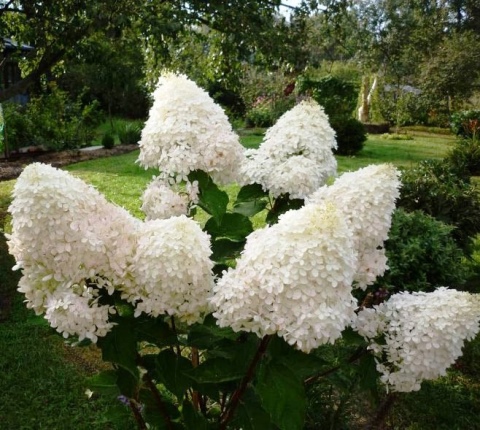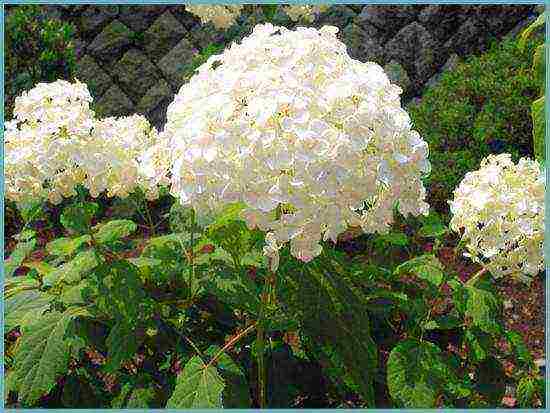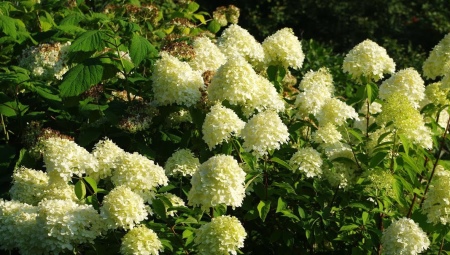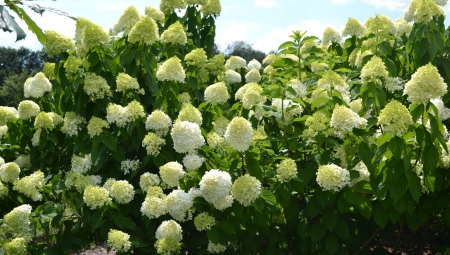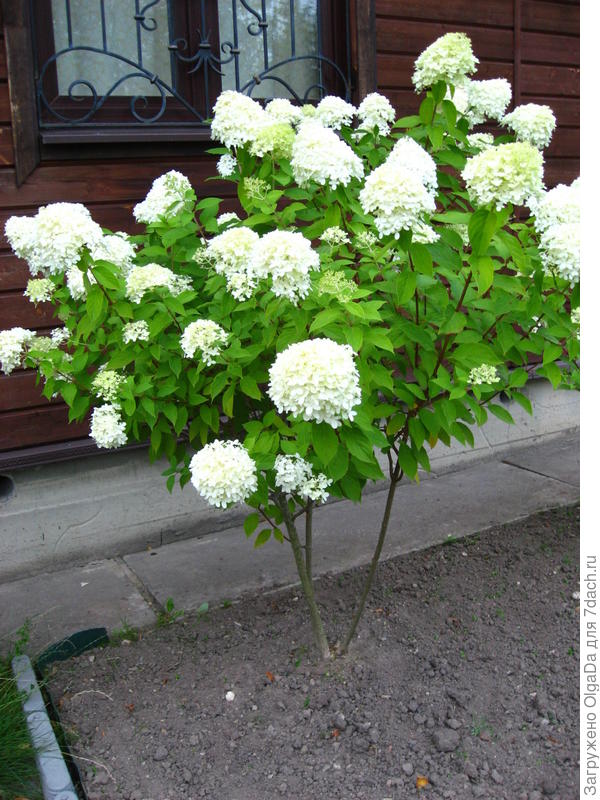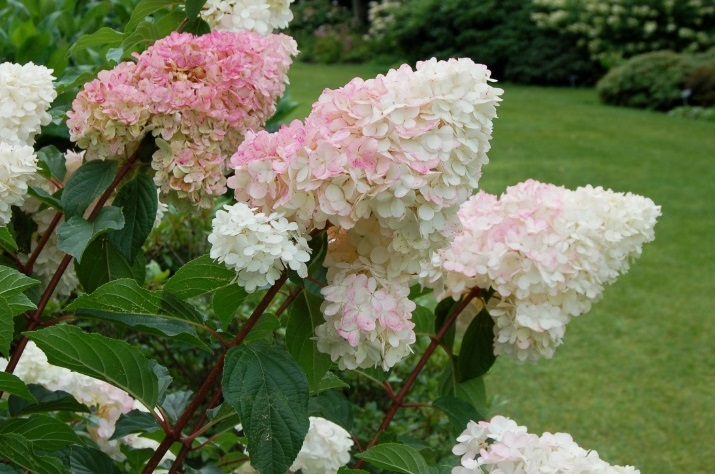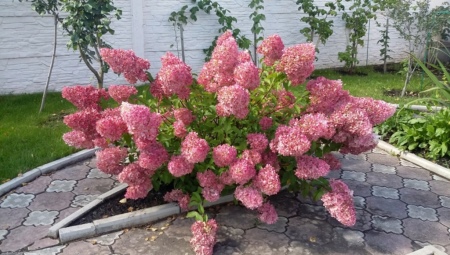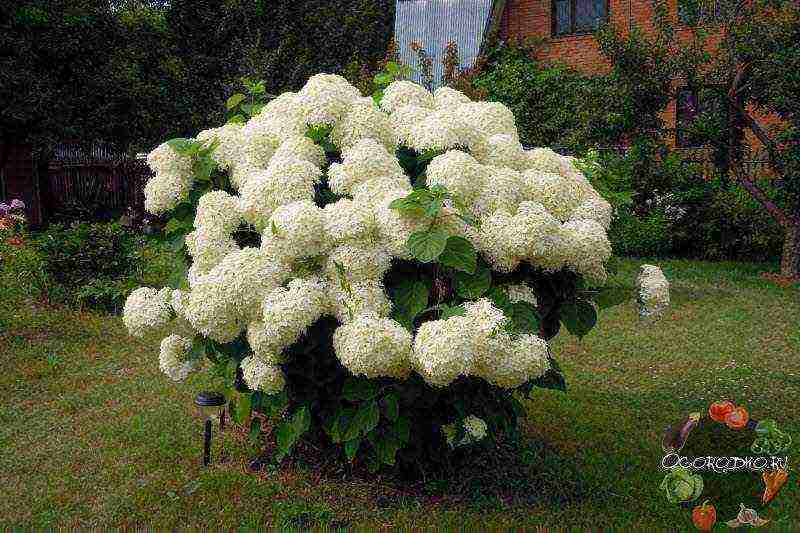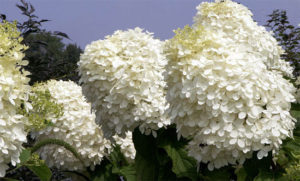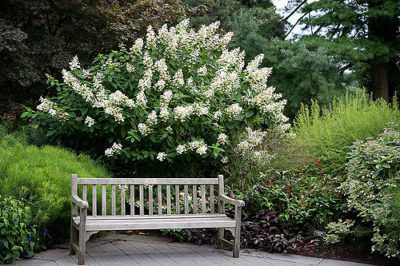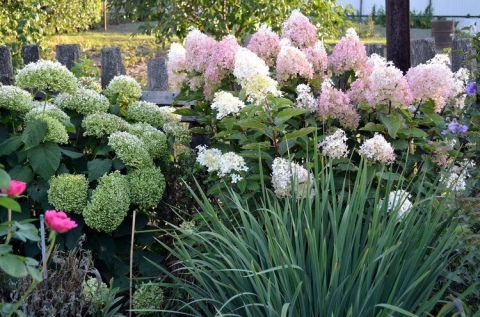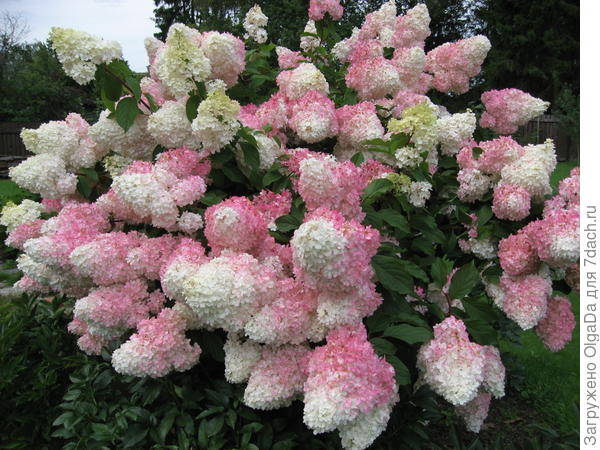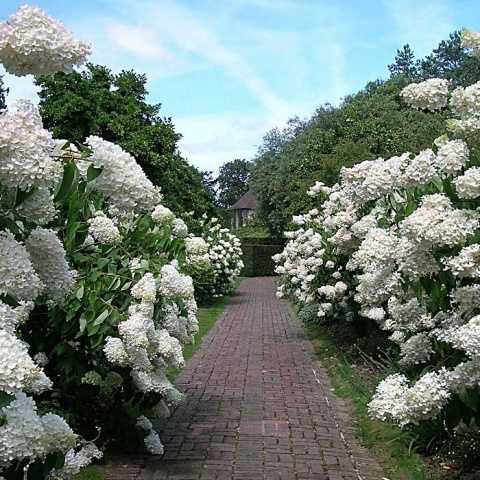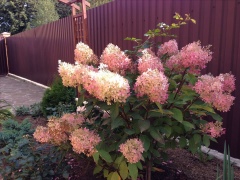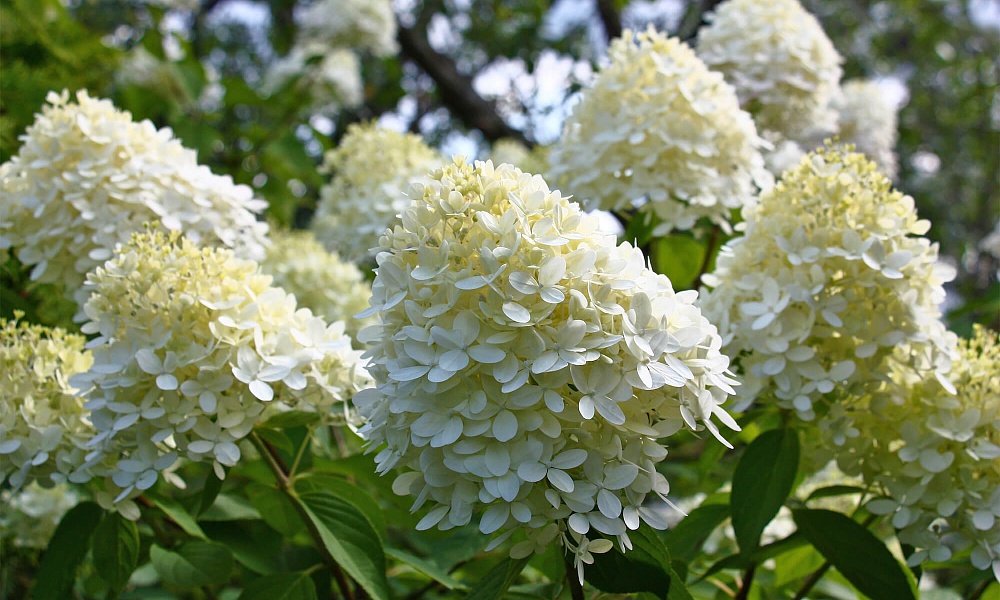How to care?
Gardeners who do not have sufficient experience in growing this variety of hydrangea should know that, despite the love of moisture, the Great star does not tolerate stagnant water. An adult plant should have at least 10 liters; on hot summer days, this amount should be increased. However, if several days of watering are missed during the dry period, it is not recommended to irrigate the plant abundantly - such sudden changes can negatively affect the condition of the shrub.
The plant care scheme includes a number of activities. Hydrangea is watered approximately once a week, making sure that the ground in the near-trunk circle does not dry out; in the heat, the plant needs to be watered about twice every 7 days. After moistening, loosening and weeding are carried out. If you constantly mulch the soil at the roots with humus, needles and sawdust, then you do not need to loosen it after each watering. Instead of mulching, some growers use ground cover crops such as sedum or styloid phlox right next to the tree trunk circle.
It is important to apply fertilizers every half a month, the bushes are fed with nitrogen only until mid-May, then phosphorus and potassium are added. For top dressing in the spring, without which normal plant development is impossible, you can use formulations specially designed for this species - liquid agent "Crystalon", Compo or fertilizer "Agricola Aqua" containing a whole complex of minerals
Foliar spraying with Epin extra or Zircon preparations will also help the plant grow quickly, especially for new plantings.
Pruning begins at the age of 2 years of age of the bush, if the natural form is left, then in spring and autumn a sanitary haircut is carried out, in which dead, dry branches must be removed, as well as those shoots that grow inward towards the trunk. Young twigs of the current year are allowed to be shortened only by 1-2 pairs of buds, so as not to injure the hydrangea, rejuvenating spring pruning consists in shortening all shoots by 5-6 cm.
Cutting hydrangeas can be formative, and for this they choose a bush with an even trunk. First, the lateral branches are pinched, then they are completely cut evenly, without hemp. In several places, the plant is tied to supports, and annually the main trunk is continued to be cut until it reaches a height of 1.5 m. After that, the crown and frame branches are formed. The whole procedure takes up to 7-8 years.
Preparation for winter consists of sanitary pruning of all, even flowering, inflorescences and the construction of a shelter for shrubs. First, cover the near-trunk zone with leaf litter and peat with a layer of up to 20 cm. The branches of the plant can be tied up, and after the snow falls, it is necessary to cover the hydrangea with snow. It should be borne in mind that untimely or too dense covering can lead to the fact that the bush will be subject to debate, and this will lead to kidney damage.
Care features
We will find out what kind of care will ensure the prosperous life and long flowering of this magnificent ornamental shrub.
Watering
Since the root system of the plant is superficial, it cannot take moisture from the deep layers of the soil. Therefore, regular and sufficiently abundant watering is so important when growing a flower. Watering should start in spring, as soon as buds begin to form and finish just before snow falls in the fall. It is recommended to moisturize the plant especially abundantly before wintering: this will increase the frost resistance of its roots.
The average frequency of watering in normal weather is twice a week. If it is too dry and hot outside, watering is carried out in 2-3 days.And in wet, rainy weather, it is better to postpone the next humidification procedure in order to prevent the formation of a swamp in the flower bed.
The water should be used soft and not too cold. Defend tap water beforehand, otherwise, due to the high content of chlorine and lime, it will quickly make the soil alkaline.
Important: after watering, it is recommended to mulch the soil in the flower bed. This technique will help keep the roots moist for a longer period.
Top dressing
In early spring, you need to feed the hydrangea with full complex fertilizer. During the period of bud formation, a second feeding is carried out using fertilizers with a low nitrogen content. In the fall, it is recommended to add potassium and phosphorus to better prepare the plant roots for the upcoming cold weather.
Pruning
Hydrangea Diamond Rouge is pruned annually. The procedure is carried out in the spring, choosing the time early, before the start of sap flow. When pruning, all shrub shoots should be shortened by about a third of the length, if the branches are damaged, then more. Be sure to get rid of the shoots growing inside the crown and frostbitten over the winter, weak, rotten.
Keep in mind that flower buds are formed in this case on last year's shoots and the current year. Therefore, you can painlessly and without consequences part with all shoots older than two years of age, and one-year-olds and shoots with new buds should be left as much as possible.
Note that the plant is easy to carry the haircut and quickly recovers after it, increases the previous volume and splendor. On the contrary, after regular pruning, the shrub seems to come to life, it becomes more beautiful and elegant. In addition, he already gets rid of many pests and diseases by removing old broken branches.
If quality shoots remain after pruning, they can easily be used for further rooting. This is exactly what most literate gardeners do. Note that semi-lignified cuttings of hydrangea root after cutting by almost 100%.
Attention: if the main procedure is carried out in the fall, then in the spring only sanitary pruning is needed. But from the fall, it is recommended to shorten the shoots more - by two-thirds of the length
Wintering
The plant has quite a decent frost resistance, so there are no special problems with wintering. Without shelter, the shrub even survives 29-degree frosts, but only if they are short-lived. If the climate in your area is more severe, it is still recommended to insulate the plant before winter.
If we are talking about hydrangeas of the first and second years of life, it is recommended to insulate them in any case. This does not require much work - you just need to overlay the bush with spruce branches, sprinkle the root circle with bark, sawdust or dry straw.
Important: the plant's frost resistance becomes higher with age. We met the beautiful hydrangea called Diamond Rouge
This garden shrub pleases with its beauty throughout the summer, has a high cold resistance, and is not too demanding to care for. It is not difficult to grow a flower: applying in practice the simple recommendations from our article, an inexperienced gardener will also cope with the task.
We met a beautiful hydrangea called Diamond Rouge. This garden shrub pleases with its beauty throughout the summer, has a high cold resistance, and is not too demanding to care for. It is not difficult to grow a flower: applying in practice the simple recommendations from our article, an inexperienced gardener will also cope with the task.
Care
The bush can eventually grow to about 2.5-3 m in height. In August, dense paniculate inflorescences, 40 cm long, appear on hard shoots. At the beginning of flowering, the sterile flowers become white, gradually changing to pink. Paniculata hydrangea blooms from August to October. Prefers sunny or semi-shaded position, humic, slightly acidic and moderately moist soil.You can plant the plant in regular garden soil. Hydrangea paniculata "Phantom" is planted at a distance of 120 cm. The big advantage of an ornamental shrub is its frost resistance, reaching -24 degrees Celsius, climate zone 5a. Tough shoots make the plant a hardy shrub, resistant to adverse weather conditions such as wind or rain.
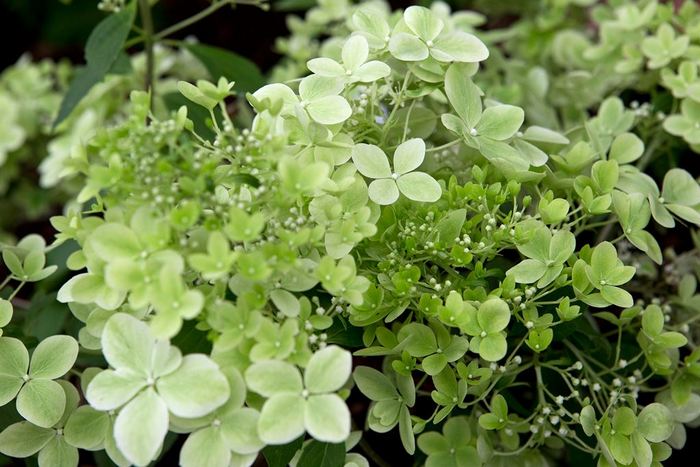
Planting and leaving
Landing takes place as follows:
A site is selected for planting a shrub. It is desirable that it be fertile and loamy, it is possible with a little acidified soil. Land with abundant lime content or sandy for hydrangea is not suitable. From the sandy soil, water quickly leaches nutrients that are vital to the flower. Also, the shrubs do not like a soil mixture with an admixture of ash. Organic fertilizers from a mixture of peat, garden soil and humus are introduced into the dug hole intended for planting hydrangeas, mixed, and drainage is introduced (if necessary). Broken brick, gravel, polystyrene can be used as drainage. After planting the seedling, it is advisable to add mulch (foliage, peat) under the bush. If planting is carried out in the fall, then it is recommended to cover the plant with a transparent plastic container and covering material. Rotted horse compost is used as mulch for autumn planting, which will additionally give the root system warmth in early spring, and when the snow melts, the flower will receive excellent feeding. In the case when covering material was used for shelter for the period of winter cold, at the very beginning of spring it should be removed in a timely manner in order to prevent the beauty of the kidneys and their death.
It is important to know that when planting, a deepening of the root collar of about two centimeters is allowed. But, if the frost damaged the shrub a little, you should not be upset. After a short period of time, the hydrangea will quickly recover and bloom with the splendor of colors.
Due to the fact that the plant has a superficial root system, it is necessary to exclude their exposure. In order to prevent overheating, periodically throw up the soil or cover it with mulching material (mowed grass, dry leaves, etc.). Top dressing is made with saltpeter, manure, calcium-based mineral fertilizers. The use of nitrogen fertilizers is prohibited. It is recommended to feed twice a month; After the panicles have faded, the bush needs proper pruning, which removes wilted inflorescences, dry and affected branches. Despite the fact that the hydrangea paniculata Fries melba is resistant to winter cold, in regions where the winter temperature drops below 30 ° C, it is recommended to cover it with spruce branches, peat, foliage, snow, film, etc.
After a short period of time, the hydrangea will quickly recover and bloom with the splendor of colors. Due to the fact that the plant has a superficial root system, it is necessary to exclude their exposure. In order to prevent overheating, periodically throw up the soil or cover it with mulching material (mowed grass, dry leaves, etc.). Top dressing is made with saltpeter, manure, calcium-based mineral fertilizers. The use of nitrogen fertilizers is prohibited. It is recommended to feed twice a month; After the panicles have faded, the bush needs proper pruning, which removes wilted inflorescences, dry and affected branches. Despite the fact that the hydrangea paniculate Fries Melba is resistant to winter cold, in regions where the winter temperature drops below 30 ° C, it is recommended to cover it with spruce branches, peat, foliage, snow, film, etc.




